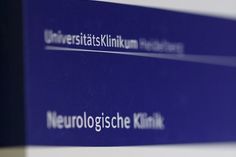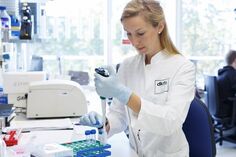Focus on acute and intensive neurology
The neurological intensive care unit in Heidelberg offers comprehensive, modern neurological intensive care medicine and training entirely from a neurological perspective. In addition to the inpatient treatment of critically ill patients, we also treat unstable patients in the emergency department and neuroradiology and, together with our anaesthesiological colleagues, provide the emergency service for the entire Kopfklinik and the NCT. Scientifically, our specialist area is one of the most recognised nationally and internationally in intensive care medicine; numerous studies are being carried out, in particular to improve the treatment of patients with severe strokes who require ventilation.
STRATEGY
The focus on acute and intensive neurology has a special clinical and scientific tradition in emergency and intensive care medicine, which has been established, maintained and further developed in Heidelberg for over 30 years. Focussing on patients with severe cerebrovascular diseases who require intensive care and mechanical ventilation, the team at the Neurological Intensive Care Unit in Heidelberg aims to improve the prognosis for these patients and restore their quality of life.
In 2010, more than 450 patients were admitted with an average length of stay of 11 days. In 2022, the number of patients rose to more than 960 with an average length of stay of 7 days. These severely affected and complex patients are cared for by a team of over 40 specialised (specialist) nursing staff, 6 assistant doctors, a specialist doctor and a section head, both of whom specialise in intensive neurology. The team in the neurological intensive care unit (12 beds) also cares for critically ill patients in the emergency department. This enables rapid diagnosis and optimal treatment through structured, individualised treatment plans. The intensive care team is also responsible for the peri-interventional management of endovascular stroke treatment and - with the support of anaesthesia - for emergency interventions and resuscitations throughout the head clinic. The overarching goals of the focus area are the development of innovative approaches in neuro-intensive care and significant participation in (inter)national collaborations that deal with the optimisation of care for patients with severe neurological conditions in emergency and intensive care medicine.
Goals
- Further scientific and clinical development of the focus on sedation and airway management in patients with severe stroke
- Strengthening the vascular medicine pillar in (acute) neurology alongside the vascular neurology section
- Structured training of rotation assistants and further training of specialists to obtain the additional qualification of neurological intensive care medicine. Maintaining or increasing the attractiveness of the department for doctors and nursing staff through more quality control and further training, as well as working in an interprofessional team
- Expansion of interaction with other intensive care units (e.g. within the hospital for specific complications such as delirium, status epilepticus, etc., but also externally, e.g. by channelling transfer requests)
- Networking for regional patient care
- Representation of the acute and intensive care neurology speciality in national and international networks (DGNI, DIVI, IGNITE, NCS) as an important basis, both for the care of patients in emergency and intensive care medicine and for future scientific projects
OVERVIEW
The research activities of the Acute and Intensive Care Neurology focus area have always been geared towards severe cerebrovascular diseases, such as space-occupying ischaemic stroke and intracerebral or subarachnoid cerebral haemorrhage. The centre was instrumental in the founding of the Association for Neurointensive Medicine (ANIM), later renamed the German Society for Neurointensive and Emergency Medicine (DGNI), and is an important training ground for many of the world's leading scientists in the field. Its many pioneering achievements include significant advances in the fields of decompressive hemicraniectomy for hemispheric stroke, hypothermia and microdialysis, monitoring after severe stroke and management of anticoagulation therapies.
Scientific work carried out by the Acute and Intensive Care Neurology specialisation (S. Schönenberger) focuses on research into and clinical development of airway management and ventilation therapy in patients with severe stroke.
Studies on key issues in acute and intensive care neurology have been initiated and successfully carried out:
As a speciality in Heidelberg, the intensive care unit team is responsible for the peri-interventional management of endovascular stroke therapy. With an increasing number of thrombectomies, the intensive care unit team has made a central contribution to the investigation and improvement of further aspects of peri-interventional management, including the first randomised study SIESTA, which compares light sedation without intubation with intubated general anaesthesia (SchönenbergerInt J Stroke2015, Schönenberger JAMA 2016, Schönenberger JAMA 2019). The results of SIESTA and the subsequent meta-analysis (Schönenberger JAMA 2019) are still part of the current international guideline recommendation on mechanical thrombectomy from the European Stroke Organisation. The intensive care unit team has thus played a role in the development of treatment standards for acute occlusions of large vessels in ischaemic stroke.
The first randomised study on blood pressure management during thrombectomy(INDIVIDUATE) investigated individualised versus standardised target blood pressure until successful mechanical recanalisation (Chen European Stroke J 2021, Chen Stroke 2023). The results not only form the initial basis for answering this question, but also for expanding the scientific focus of the section (e.g. through collaborations, but also by initiating a multicentre study).
Securing the airway is closely related to oxygenation in stroke patients. The safety, feasibility and potential benefits of an early tracheostomy were examined in the first prospective, randomised SETPOINT pilot study (Bösel Stroke 2013) and a trigger score was developed to indicate the need for a tracheostomy (Schönenberger Neurocrit Care 2015). Building on these and earlier successes, the focus was expanded to develop and conduct international multicentre studies, such as the follow-up study on early tracheostomy SETPOINT2 (Schönenberger Int J Stroke 2016, Bösel JAMA 2022).
At a national and international level, the Acute and Intensive Care Neurology focus area is part of several collaborations and networks such as the DGNI (German Society for Neurointensive and Emergency Medicine) with its IGNITE research network, the German Interdisciplinary Association for Intensive Care Medicine (DIVI) and the Neurocritical Care Society (NCS).






